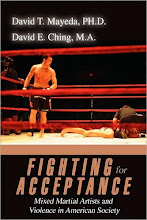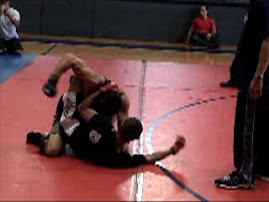
The L.A. Times has a very interesting article up (11.26.09), "Returning favor to a park: A recreation area once claimed by gangs has been turned into a vibrant community hub with help from an ex-Avalons heavy-hitter." It provides sociological information, demonstrating how larger macro forces historically set the stage for gang development in South Los Angeles. The story revolves around a current gang member, "Blue," and his ongoing commitment to a broader social responsibility, seen through his efforts to redevelop a park and make it open too all residents, including rival gang members and their families.
He is 38 now, with a barrel chest and Popeye forearms that belie the gray hairs in his goatee. In the gang world, he and his contemporaries are of a specific age. They were the first to become men during the truly terrible years in South L.A. 20 years ago, when crack cocaine came through like a tempest and gangs were averaging a killing a day.
Everyone, he said, seemed to desert them at once. Many of their parents were lost to drugs; his own mother was murdered and his father was addicted and absent, like most of the fathers he knew at the time. The police, he said, became cruel and combative. The schools offered little hope. The factory jobs on Alameda and Slauson — the jobs that had lured his grandparents from Louisiana, like thousands of other African American families — were gone. Blue and his friends had hustled a little cash by offering to pump gas for customers at the local stations; soon, even that was taken away, as crackheads kicked the boys out and took over.
"We didn’t have a man at home. I never had a single man walk through the door and say, ‘I paid the light bill today.’ None of us did,” Blue said.
"So now your mom is getting high. The lights get turned off. The house is getting stinky. We all looked at each other and said: ‘Well, I guess it’s just us now. We ain’t got no malls, no colleges, no jobs. But everybody wants to be a part of something. All we could do is claim . . . this."
He stretched his arms wide; he meant the park.
As implicitly stated, when economic opportunity rapidly declines due to the "free market" and global economy, the disastrous rippling effects are numerous. In addition to poverty, familial stress, the underground drug economy, community-police tensions, substance use, gang development, and youth violence all increase.
While the empirical research has found overwhelmingly that interventions should not encourage gang members to retain their gang affiliation in programs, the best part of this story covers the way in which law enforcement and "Blue" compromised and came to an agreement so that they could open up a park for constructive community use. At least thus far, the results appear very impressive in shifting a crime-ridden park to a sort of safe heaven for local residents:
["Blue"] also launched a tradition called “Spread Friday.” Each week he and his friends make a goulash of sorts, using only ingredients that are also available for purchase inside local jails: ramen topped with smoked oysters and canned beef, honey, jalapeños and crushed Doritos, tossed inside a garbage bag and doled out to all takers, who are surprisingly many — and eager. The meal, said Blue — who in his 20s served 22 months in prison for robbery — is a reminder that life will always be better on the outside.
Once Blue had signed off on the notion of the Avalons cooperating with the city — or at least allowing the community unfettered access to the park — the floodgates opened.
Using grants and money routed from City Councilwoman Jan Perry’s office, the park built a playground, replaced the gym floor and refurbished a band shell. The park launched a series of music performances. During the first concert, featuring blues and jazz, “everyone held their breath,” Cox said. Nothing happened. So at the next show, Cox asked Blue and his comrades — “the big, bad Avalon Crips,” Cox said with a grin — to provide security. It worked without a hitch.
Today, there are talent shows, tutoring programs, toy giveaways at the holidays. An aerobics class has exploded in popularity; more than 200 women are registered, making it one of the city’s largest park programs for adults. The class is so large that the instructor had to develop hand signals to telegraph dance moves. There are more than 700 children enrolled in classes and sports programs. And there are 18 kids in the preschool.
This is a must-read for those engaged in community work aiming to decrease and prevent community violence. The story illustrates the need for leaders from different organizations to compromise and make LONG-TERM, COLLABORATIVE COMMITMENT to the community.









No comments:
Post a Comment